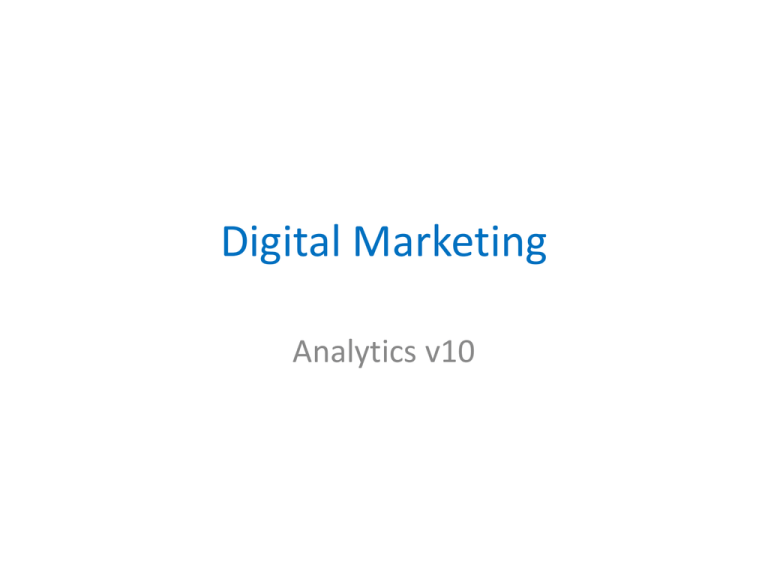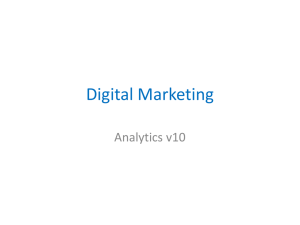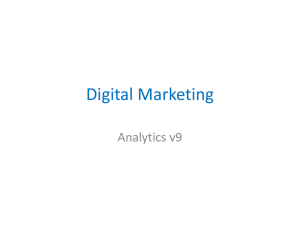Search Engine Reports
advertisement

Digital Marketing Analytics v10 Introduction Name / job role What company are you with How much experience do you have using Webtrends Create a Word document for your notes .. Agenda Digital Marketing Overview Web Analytics Web Analytics When implementing web analytics for the first time, you will want to gain insight into the initial visitor metrics: (Benchmarking) How many daily visitors you receive Your average conversion rate (sales, registration, download, etc.) Top visited pages The average visit time on site and how often visitors come back The average visit page depth and how this varies by referrer The geographic distribution of visitors and what language setting they are using Web Analytics Web Analytics Digital Marketing Terminology Terminology Hit - A hit is any request to a web server. Each time a visitor downloads a page, clicks a hyperlink, views a graphic, or performs any other action on a web site, a call is made to the web server. The web server records each of these requests in a log file. These requests are commonly known as "hits," and the loading of a single web page can amount to many hits, due to all of the elements it contains. Page View - A page view represents a hit to any file designated among the page file types. The most common examples are files ending in .html, .htm, .php, .asp, or .aspx. Defined when WT.dl=0 Terminology Webtrends parameter (WT.dl) You should use this method if you use Webtrends On Demand or SmartSource Data Collector (SDC) with the Webtrends tag. This method identifies a hit as a page view whenever the wt.dl parameter is present in the server call and has a value of zero (0). Terminology Visit - A visit is a session of continuous activity where all hits are recorded in the log file for one visitor to a web site. The visit starts the moment of the first hit on the web site and continues until the session ends: - 30 minute period of inactivity (default) - the visit ‘crosses’ a reporting time period Active Visit – An ‘open’ visit count that occurs in a defined time period. Terminology Webtrends OnDemand aggregates the visitor data to five standard time periods: Time Frame Daily Weekly Monthly Quarterly Yearly Terminology Webtrends OnDemand aggregates the visitor data to five standard time periods: Monday Tuesday Wed Thursday Friday Saturday Sunday Visits 3 Visits 3 Visits 1 Visits 3 Visits 2 Visits 3 Visits 2 Visitors 3 Visitors 2 Visitors 1 Visitors 3 Visitors 2 Visitors 2 Visitors 2 Terminology Unique Visitor / Unique User - The uniquely identified client generating requests on the web server (log analysis) or viewing pages (page tagging) within a defined time period (i.e. day, week or month). A Unique Visitor counts once within the timescale. A visitor can make multiple visits. Identification is made to the visitor's computer, not the person, usually via cookie and/or IP+User Agent. Thus the same person visiting from two different computers will count as two Unique Visitors. Terminology New Visitor - A visitor that has not made any previous visits. This definition creates a certain amount of confusion (see common confusions below), and is sometimes substituted with analysis of first visits. Returning Visitor - A visitor that has made at least one previous visit. The period between the last and current visit is called visitor recency and is measured in days. Visitors not accepting Cookies - A visitor that cant be tracked due to browsers not accepting JavaScript. Terminology Terminology Bounce Rate To understand the difference between exit and bounce rates for a particular page in your site, keep in mind three things: For all sessions that start with the page, bounce rate is the percentage that were the only one of the session. For all page views to the page, the exit rate is the percentage that were the last in the session. The bounce rate calculation for a page is based only on visits that start with that page. Terminology Let's clarify this last point with a simple example. Your site has pages A to C, and only one visit per day exists, with the following page view order: Monday Tuesday Wednesday Page A Page B Page A Page B Page A Visit finished Page C Page C Page A: 3 page views 50% Bounce Rate Page B: 2 page views 0% Bounce Rate Page C: 2 page views 0% Bounce Rate BR = Single Page Visits * 100 Entry Page Visits Digital Marketing Tracking Visitor Behaviour Tracking Visitor Behaviour Tracking Visitor Behaviour Filtered for Spiders, Bots, Crawlers and Image requests May have filters applied to remove internal IP addresses Filtered to meet specific reporting requirements Tracking Visitor Behaviour The main objective of web analytics is to understand how web visitors are using your site (what pages are visited and what actions are taken) so that you can determine if they are doing what you want them to do. Are visitors making purchases or downloading white papers? Are visitors responding to ads? Are visitors reviewing your technical support materials rather than calling your technical support ? But how can you tie activity to individual visitors? How can you tell whether a hit to a product information page and a hit to the pages of a shopping cart were all done by the same visitor? Tracking Visitor Behaviour Webtrends identifies the visitor using a First Party Cookie. When the profile is first analysed and Visitor History is enabled, Webtrends creates a Visitor History Table that tracks the activity of each unique visitor analysed for that profile. The Profile is configured to collect the visitor activity you require, e.g. campaign history.. and Webtrends will use specific query parameters to track the activity. List of VHT parameters can be found in the manual. Digital Marketing Standard Analytics v10 Reports Analytics v10 Reports The report sets that come by default when a space is created will be categorized into one of these report categories: Content Events People Technology Traffic These categories can also be selected as the report category for existing custom reports. Digital Marketing Reach Reports Analytics v10 Reports Analytics v10 Reports Campaigns Campaign Reports Traffic People CampaignIDs Searches: Domains Conversion Page Search Engines: Geo: Landing Page Referrers: Visitors (Preconfigured) Marketing Category A9 Traffic Sources: Campaign Reports Campaign Reports Organic Search You Tube, Blog, RSS, Podcast, Home Page, Portal Direct Mail, Email Landing Page, Competition Paid Search Retail Outlets TV spots, Print, Radio Sponsorship, Display Ads Facebook, Twitter CRM Point of Sale, Kiosks PR, Events, Tradeshows, Conferences Campaign Reports Tracking multi channel campaigns: Append the link with the WT.mc_id = <value> tag (unique identifier) http://www.partnersite.com?WT.mc_id=11011 Campaign Reports Campaigns Shows the visitors' most recent campaigns during the report time period. For the report time period, all conversions and other activities are tracked and attributed to the last campaign to which visitors responded. Thus, even if the conversion does not happen on the first visit generated by the most recent campaign, the appropriate source is "credited" with the conversion. Drilldown levels may be the result of a custom dimension definition or from an applied campaign translation file. Campaign Reports Campaign Reports Uses and Interpretation: Use this report to determine the campaign IDs that generate the highest amounts of desired activity. As you launch new campaigns, or tweak campaign messaging, note how your actions change the results. Are visitors from a particular campaign viewing more pages or making more purchases? Are there certain campaigns that tend to generate the best response? Because Webtrends counts one visit for each campaign viewed, and a visitor may view several campaigns in one visit, this report does not show totals for visit-related measures. Campaign Reports Campaign Reports Campaigns by New vs. Returning Visitors Shows how effective your most recent campaigns are at generating New vs. Returning visitors. With drilldown the user can examine this information at a highly summarized level and navigate to successively more detailed levels of campaign data; for example, viewing new vs. returning visitors by Demand Channel, Partner, Marketing Program, Marketing Activity, Campaign ID, and Campaign Description. Traffic REFERRER REPORTS Referrer Reports Referrers: Sites Identifies web sites that refer visitors to your site. The top referrers are your site's primary channels, and may include a partner sites, search engines, portals or marketing programs. Referrers: Names Identifies domains that refer visitors to your web site. Referrers: Pages Shows the pages from which visitors accessed your site. You can use this report together with the Top Referring Domains report to identify which pages on your top domains are sending the most traffic to your site. Traffic SEARCH ENGINE REPORTS Search Engine Reports 10% 20% Search Engine Reports WT.srch=1 Include this query parameter in the link URL to differentiate paid placements. http://www.whatever.com/default.aspx?WT.mc_ID=10001&WT.srch=1 Allows WTOD to differentiate between visitors coming from a paid placement versus an organic search on the same search engine Enables the following pre-defined custom reports Search Engines : Paid Search Phrases : Paid Search Engine Reports Search Engine Reports Most Recent Search Engines (All) Displays the most recent search engine and phrases that visitors used to access your site with measures evaluating those visits. Search Engine Reports Search Engines : Organic Displays the most recent organic search phrases and search engines that visitors used to access your site with measures evaluating those visits. Search Engines : Paid Displays the most recent paid search phrase and engine that a visitor used to access your site with measures evaluating those visits. Search Engine Reports Uses and Interpretation: This report allows you to analyze visitors' current activities regardless of whether the search was based on a paid or organic most recent search phrase. Use this report to analyze how effective search engines and specific phrases are at generating visitors who often return to your site to perform the actions you want them to take. By including conversion metrics, you not only evaluate the performance of search phrases in driving traffic, you also get an indication of how well your site is optimized for those phrases. In other words, how well does your site meet visitor interests (their query) and convert on that traffic? Search Engine Reports Search Engine Reports ‘Search phrase not provided’ • In October 2012, Google started to encrypt, via Google SSL, all outbound clicks in their search results for users that are signed into any of Google's websites (which means any user signed into Gmail, YouTube, Google Plus, Google Maps, and more). The result removes keywords / phrases from the Referrer URL, displayed as ‘Search phrase not provided’ in Webtrends reports. • Firefox 14 also uses Google SSL. • Bing and Yahoo are not affected. • For iOS 6 users, the picture is slightly more complicated. If the search phrase is entered using the default Safari browser, then the complete Referrer URL is removed, resulting in ‘Direct Traffic’. If the search term was entered on a Google homepage (i.e google.com) then just the search keywords / phrases are removed. Traffic TRAFFIC SOURCES REPORTS Traffic Sources Reports The table below illustrates how the Traffic Source dimension is determined. The Traffic Source is determined by going from top-to-bottom through this logic. Traffic Source Referrer Field Search Engine Social Media WT.srch=1 WT.mc_id Paid Search Not Empty YES NO YES YES/NO Organic Search Not Empty YES NO NO N/A Social Campaigns Not Empty NO YES NO YES Social Not Empty NO YES NO NO Referring Sites Not Empty NO NO NO NO Other Campaigns Not Empty NO NO NO YES Other Campaigns Empty N/A N/A NO YES Unknown Referrer Empty N/A N/A NO NO Traffic Sources Reports * Search Engine is determined by matching the referrer field to an entry in the keywords.ini file. There must be a string match in the domain, and there must be an accompanying query parameter indicating the search phrase. ** Social Media is determined by matching the referrer field to an entry in the keywords.ini file in which "Social=1" is present. This is a string match on the domain. People DOMAIN REPORT People Reports Domains: Organizations Be aware that the list of Domains / Organisations will include ISP Providers. People GEOGRAPHICAL REPORTS People Reports Geographical Drilldown People KEY METRICS REPORT People Reports Key Metrics The Key Metrics report is a good place to gain an overview of visitor metrics. Below are definitions of some key measures. Active Visits An active visit is different from a visit in that an active visit includes visits that have not yet closed, whereby a visitor leaves the site or remains idle for longer than the idle-time limit. For example, compare daily visits to daily active visits when the end of the report period is every day at midnight. A daily visit report will not include visits that start before midnight and cross over the daily boundary because those visits have not yet closed as they were still open at the end of the report period. A daily active visit report will include open visits without regard to the daily boundary. Active visits will therefore report a higher number of visits than a standard visit measure because active visits include all visits, even those not yet closed within the report period. Digital Marketing Engage Reports Engage Reports Engage Reports Content Path Analysis People Technology Categories Drilldown Set ‘landing page’ Visits: Depth Browsers: File Types Or ‘content group’ Visits: Duration Mobile: Onsite Searches: Pages: Site Pages Visits: Frequency Content CATEGORY DRILLDOWN REPORT Content Reports Site Navigation Themed Pages Segment Categories Drilldown Content Reports Categories : Drilldown Content Reports Site Pages Identifies the most popular pages on your site and shows you key metrics for each page such as Visits, Page Views and Active View Time. Site Pages with good content and design are more likely to attract visitors and be revisited. Less popular pages on a site can be made more appealing by improving the content or incorporating design elements similar to that on the more important pages. Always remember that people are far more interested in content than in design, and Average View Time can help determine which content is most important to your visitors. Content Reports Content FILE TYPES REPORT Content Reports File Types This report provides summary statistics on the file types that can be accessed on your site. It highlights the file types that are driving the greatest data transfer volumes on your site. Cached requests and file requests that resulted in errors are not included. Content ONSITE SEARCH REPORTS Content Reports Onsite Search This report provides information about on-site searches that were successful. Uses and Interpretation: This report provides you with insight into the top on-site search terms that serve up related results. Since this is "Search Terms Found," these terms do have related content on your site but the content is not immediately apparent to the user, thus they have entered this term in search. It is often helpful to assess the top search terms found and potentially make adjustments to your site, bringing greater immediate visibility to this content. An example may be to update the homepage navigation and or homepage messaging. Content Reports Onsite Search This report provides information about on-site searches that were successful. Uses and Interpretation: Keep in mind that for every person who makes the effort to enter an on-site search, a handful of other people simply abandon the site if they are not immediately finding what they are looking for at the time. Bringing greater visibility to the top search terms found will ultimately increase the overall site performance. Content PAGES : ENTRY REPORT Content Reports Pages : Entry A visit can begin on a given page if a visitor: types the URL of the page in their browser then clicks on "Go" clicks on a bookmark to the page (stored from a previous visit) clicks on a link on a different site that points to the file. The link can appear to be text or an image, such as a banner ad. clicks on a link to the page in an e-mail. Again, the link can appear to be text or an image. clicks on a link on a search engine results page that points to this page activates an applet on another site or in a program that transfers them to this page Content Reports Uses and Interpretation: Look at each page on the Entry Pages report and ask yourself whether it is suitable as the first page a visitor sees. For example, it can be argued that entry pages should: identify the site and/or brand have a clear link to the home page show the same navigation bars as the rest of the site If a page that's frequently an entry page doesn't do all these things, consider modifying it to conform to best practices. Content PAGES : EXIT REPORT Content Reports Pages : Exit If a visitor is inactive for a period time, Webtrends counts the visit as "ended" (default: 30 minutes of inaction). Visitors may have: Browsed to a different site, and not returned within the idle time Closed all their browser tabs, and not returned within the idle time Remained inactive for more than 30 minutes but did not leave your site Note: that if a visitor resumes clicking on your site after 30 minutes of inactivity, Webtrends records two visits, one before and one after the pause. Consequently, the last page viewed before the long pause will appear as an Exit Page, the first page viewed after the long pause will appear in the Entry Pages report, and your own domain will be the referring domain. Content Reports Uses and Interpretation: Examine each exit page in the report and ask yourself whether it can be considered a desirable or undesirable ending point for a visit. For example, a purchase thank-you page would be a desirable end of a visit, but a page in the middle of a registration process would be undesirable as a last page. Undesirable Exit Pages may indicate a problem needing addressing, such as: a difficult multi-step process a page that takes too long to load content that does not hold the visitors interest confusing navigation Path Analysis PATH ANALYSIS REPORTS Path Analysis Path Analysis: Use this report to look for weaknesses and to understand visitor content and navigation preferences: Compare the most common paths in this report to those you expected when planning your site. Are they the same? If not, perhaps visitors are confused by your navigation ... or perhaps you predicted their paths incorrectly. Ask if your visitors are leaving the site earlier than you would like. Pay special attention to the short paths. Are too many visitors leaving the site before they know what your site is about? Does knowing the exit pages help you understand why? Path Analysis The page where visitors started to view the site. This line connects the pages that make up the path selected to view. Digital Marketing Activate Reports Activate Reports Activate Reports Scenario Analysis Funnel Reports Scenario Analysis SCENARIO ANALYSIS REPORT Scenario Analysis The corresponding numbers include the number of visits that entered and exited the scenario at this step and the total number visits (conversions) from the previous step. This rate is calculated by dividing the number of visits to the final step by the total scenario entries on all steps. This rate is calculated by dividing the number of conversions from one step to the next (shown in green) by the total number of visits on the prior step. Digital Marketing REST API REST API The Data Extraction API conforms to the REST (Representational State Transfer) architectural style, using the HTTP protocol and a URI to access resources. Integrates with Excel without coding, client software, or installed driver-you need only your Webtrends credentials to get data Returns the entire data set for a trend in response to a single URI (for example, trending a week by hours) Is profile and account independent, so you can list multiple profiles by changing the profile name in the URI REST API There are two main ways of creating the REST request: Analytics 10: via the “Share” option when viewing a report from within the Webtrends Analytics 9 Insight user interface. REST Generator: is an application that helps you rapidly create a request for profile or report data. Digital Marketing Summary Summary









